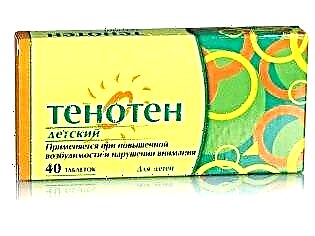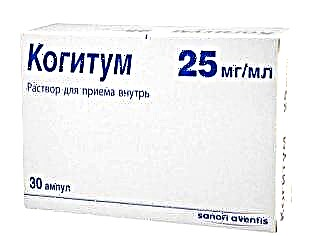
Pantocalcin is a nootropic drug often prescribed for adults with parkinsonism, head injuries, neuroses, tumors and other pathologies of the nervous system. Can this medicine be given to children when it is used in childhood and in what doses?
Release form
The only form of Pantocalcin is tablets, which are flat-cylindrical and white in color. They are sold in blisters of 10 pieces (total in a pack of 50 tablets) or in jars of 50 pieces. Pantocalcin has no other dosage forms (syrup, suspension, injections, capsules).


Composition
The main ingredient of the drug, which ensures its effect on the tissues of the nervous system, is represented by hopantenic acid in the form of a calcium salt. Depending on the amount of such a substance, tablets are produced in two dosages - 250 mg and 500 mg. For density and shape maintenance, potato starch and calcium stearate, as well as talc and magnesium hydroxycarbonate, are added to the medicine.
Operating principle
Pantocalcin has a direct effect on brain tissue, since hopantenic acid has GABA in its structure, an important neurotransmitter. The drug has a neuroprotective effect, which consists in increasing the resistance of neurons to the effects of oxygen deficiency or harmful substances.
The drug also has neurometabolic and neurotrophic properties, that is, it improves metabolic processes in brain cells and increases their efficiency. Pantocalcin also has an anticonvulsant effect, and the ability to inhibit an increased cystic reflex.


Indications
The drug is prescribed for such diseases and disorders in the functioning of the nervous system:
- Cerebral palsy.
- Postponed neuroinfection.
- Epilepsy.
- Delays in speech, mental development, or motor skills.
- Neurosis.
- Traumatic brain injury.
- Stuttering.
- Extrapyramidal syndrome.
- Schizophrenia.
- Enuresis and other neurological problems with urination.
- Reduced physical or mental performance.
- Memorization disorders.
- Strong emotional and mental stress.
- Concentration problems.


At what age is it prescribed?
In the annotation to Pantocalcin, it is noted that such tablets are not used in the treatment of children under 3 years of age. This is due to the difficulty of young children in swallowing solid medicine. If treatment is required for a patient in the first years of life, such a medication is replaced with an analogue called "Pantogam", since one of its forms is a syrup that is approved for the treatment of children from birth.
However, some doctors still prescribe Pantocalcin to children under three years old, recommending that the tablet be ground before taking it into powder.


Contraindications
Pantocalcin is not given if the child has:
- There is an intolerance to hopantenic acid or any of the auxiliary components of the tablets.
- Severe kidney disease developed, leading to renal failure.

Side effects
A child taking Pantocalcin may develop an allergic reaction to such tablets in the form of a skin rash, dermatitis, runny nose, conjunctivitis, or other manifestation of allergies. If such symptoms are found, treatment should be stopped immediately and a doctor should be consulted for a different therapy.
The nervous system of some young patients reacts to the intake of Pantocalcin with symptoms such as agitation, insomnia, or headaches... Other children, on the other hand, feel during treatment lethargy, lethargy, drowsiness, dizziness. Such negative reactions, as a rule, disappear if the dosage of the drug is reduced.

Using
Instructions for use recommend drinking Pantocalcin after meals in the morning or afternoon. The optimal period for taking the pills is considered 15-30 minutes after lunch or breakfast. It is not worth taking medication in the evening (later than 17:00), as it can affect your night's sleep. The tablet should be swallowed whole, but if there are difficulties with this, it is permissible to grind it into powder and give it to the child in this form, and then suggest drinking it with water.
The dosage and duration of treatment with Pantocalcin in childhood is determined based on the diagnosis. Usually the drug is given 1 tablet per appointment (the dose can be 0.25 g or 0.5 g), and the average duration of the course is 30-60 days, but if necessary, it can be extended to 4-6 months or even a year. The daily dose of the drug varies from 750 mg (three tablets of 250 mg) up to 3000 mg (six tablets of 500 mg).
For example, if a child has a delay in the development of speech, the drug is prescribed for 2-3 months, 500 mg per dose three times or four times a day. With asthenia or increased stress, the medicine is given at 0.25 g three times a day for a month. At the same dose and just as often, the drug is taken to eliminate the effects of brain injury or infection. If a small patient has epilepsy, the drug is used at 250-500 mg 3-4 times a day for 6 months.
In the dose prescribed by the doctor, Pantocalcin is not given immediately. During the first week of use or a little longer (if the course is long), it is increased gradually and the patient's response is monitored.
Cancellation of the drug should also not be abrupt - 7-8 days before the end of the course, the dosage begins to be lowered until the intake is completely stopped.

Overdose
The consequences of an overdose of Pantocalcin are usually negative symptoms from the central nervous system, which are found among the side effects of the tablets. In case of an overdose, the child's stomach should be flushed, and then an adsorbent drug should be given.

Interaction with other medicines:
The manufacturer informs:
- Pantocalcin is able to enhance the effect of drugs that stimulate the nervous system, therefore, the appointment of tablets together with such drugs or other nootropics should be under the supervision of a physician.
- Pantocalcin is often prescribed together with "Tenoten", "Magne B6", "Nervohel" and other drugs acting on the central nervous system, but such combinations cannot be given without a doctor's prescription.
- When used simultaneously with barbiturates or anticonvulsants, Pantocalcin increases their effectiveness and reduces the risk of side effects.


- Treatment with Pantocalcin helps prevent the harmful effects of antipsychotics or eliminate the negative consequences after a course of treatment with such drugs.
- If you give Pantocalcin together with Glycine, then the effect of the drug will be more pronounced.
- Under the influence of hopantenic acid, the therapeutic effect of local anesthetics is enhanced.


Terms of sale and storage
To buy Pantocalcin in a pharmacy, you need a prescription from a doctor. The average price of 50 tablets of 250 mg is 400-450 rubles, and a package of drugs with a higher dosage is about 700 rubles. It is necessary to store the drug at home at temperatures up to +25 degrees Celsius. The storage location should be dry and out of reach of small children. The shelf life of the tablets is 4 years.

Reviews
Reviews of neurologists and pediatricians on the use of Pantocalcin in children are predominantly positive. This tool is widely used in pediatrics for both preschoolers and schoolchildren, noting that the medication helps to accelerate development, assimilate material, master new skills, and improve sleep. According to doctors, the use of pills effectively eliminates anxiety, tantrums, frequent awakenings at night and other negative symptoms.
Most of the reviews about Pantocalcin from parents are also positive. In them the tool is called effective and emphasize that after the course of treatment, the child began to speak in long sentences, was less tired at school, expanded his vocabulary, and so on.

However, there are also negative reviews in which they complain about side effects (for example, an restless or lethargic state) or the lack of the expected effect.
We also note that some doctors, including the popular pediatrician Komarovsky, consider Pantocalcin and other nootropic drugs to be drugs, the use of which has not been proven. In their opinion, although they do not cause any harm to the child's body, the effectiveness of such medications is low, therefore, their appointment for RRD, enuresis, tics and other serious problems is inappropriate.


Analogs
As mentioned above, Pantogam is an analogue of Pantocalcin in terms of the active ingredient. This medicine is produced not only in tablet form, but also in the form of a sweet syrup, which allows it to be given to children under three years old.
The indications, possible negative effects and even dosages of these drugs are the same.
In addition, if necessary, the doctor may recommend another nootropic to replace Pantocalcin, for example:
- Suspension "Encephabol", which is prescribed for encephalopathy, developmental delay, intracranial injuries and other pathologies from birth (from the third day of life). The medication is also available in tablets, approved from the age of 7.
- Glycine tablets that can be given to children of any age. They are in demand for improving memory, stimulating mental activity, normalizing sleep rhythm, protecting the brain from stress.
- Cogitum solution, which has a pleasant banana flavor. This drug of acetylamino-succinic acid is used for RRR, head injuries, neurosis and other pathologies in children over seven years old (sometimes it is prescribed for younger patients).


- Ampoules "Cortexin", the contents of which are administered intramuscularly to children of any age. Such injections are prescribed even to premature babies if they have a birth injury, encephalopathy or other pathology of the central nervous system.
- Aminalon tablets containing GABA and allowed for children over one year old. They are used in the treatment of cerebral palsy, traumatic and other brain lesions.
- "Phezam" capsules, the composition of which includes two components at once to improve brain function - cinnarizine and piracetam. They are used for asthenia, memory impairment, motion sickness and other problems from the age of five.



